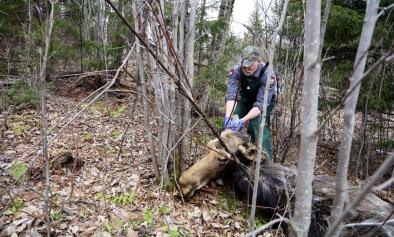Decadal-scale phenology and seasonal climate drivers of migratory baleen whales in a rapidly warming marine ecosystem
Study key findings & significance
- Climate change is having an impact on how large whale species, including the critically endangered North Atlantic right whale, use habitats in the warming Gulf of Maine, showing that right whales' use of Cape Cod Bay has shifted significantly over the last 20 years.
- Highly migratory marine mammals can and do adapt the timing of their habitat use in response to climate-driven changes in their environment, with results showing increased habitat use by right whales in Cape Cod Bay from February to May, with greatest increases in April and May.
Author quotes
"The time of year when we are most likely to see right and humpback whales in Cape Cod Bay has changed considerably, and right whales are using the habitat much more heavily than they did 20 years ago."
"Changes in when whales use their traditional habitats has important implications for the design of protected areas. This issue is especially important as climate change continues to alter animal migrations."
Dan Pendleton, lead author and Research Scientist in the New England Aquarium's Anderson Cabot Center for Ocean Life
Abstract
Species' response to rapid climate change can be measured through shifts in timing of recurring biological events, known as phenology. The Gulf of Maine is one of the most rapidly warming regions of the ocean, and thus an ideal system to study phenological and biological responses to climate change. A better understanding of climate-induced changes in phenology is needed to effectively and adaptively manage human-wildlife conflicts. Using data from a 20+ year marine mammal observation program, we tested the hypothesis that the phenology of large whale habitat use in Cape Cod Bay has changed and is related to regional-scale shifts in the thermal onset of spring. We used a multi-season occupancy model to measure phenological shifts and evaluate trends in the date of peak habitat use for North Atlantic right (Eubalaena glacialis), humpback (Megaptera novaeangliae), and fin (Balaenoptera physalus) whales. The date of peak habitat use shifted by +18.1 days (0.90 days/year) for right whales and +19.1 days (0.96 days/year) for humpback whales. We then evaluated interannual variability in peak habitat use relative to thermal spring transition dates (STD), and hypothesized that right whales, as planktivorous specialist feeders, would exhibit a stronger response to thermal phenology than fin and humpback whales, which are more generalist piscivorous feeders. There was a significant negative effect of western region STD on right whale habitat use, and a significant positive effect of eastern region STD on fin whale habitat use indicating differential responses to spatial seasonal conditions. Protections for threatened and endangered whales have been designed to align with expected phenology of habitat use. Our results show that whales are becoming mismatched with static seasonal management measures through shifts in their timing of habitat use, and they suggest that effective management strategies may need to alter protections as species adapt to climate change.
Related Content



